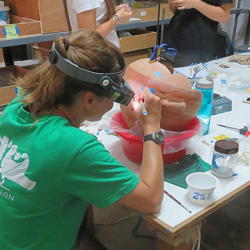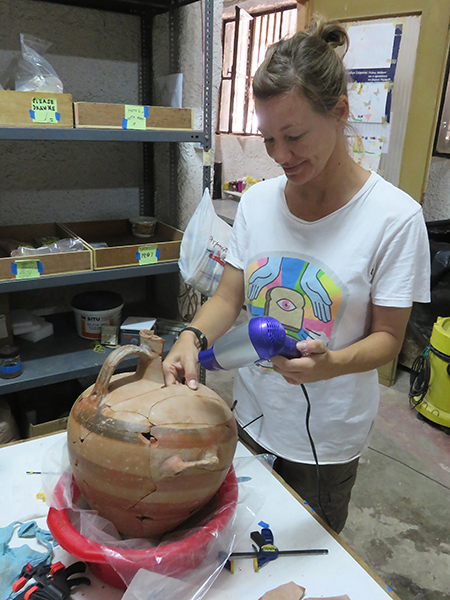Vanessa Muros Awarded Boochever Endowment

Vanessa Muros, PhD, has been awarded the Kathleen and David Boochever Endowment Fund for Fieldwork and Scientific Analyses by the Archaeological Institute of America. The Boochever Fund supports fieldwork or laboratory research informed by new technologies. Muros is the director of the Experimental and Archaeological Sciences Laboratory at the Cotsen Institute of Archaeology at UCLA.
The project for which she received the award will test the efficacy and reliability of two low-tech methods: Ultra-Violet Induced Visible Fluorescence, and the Raspail test, a micro-chemical test for plant terpenoids, to analyze organic residues in pottery in the field.
Muros said that she will first be running tests on ceramic tiles she will be making in the laboratory. Based on the results she will be using the developed methods on pottery from ancient Methone in northern Greece, when she works in the field during the summer. She is a conservator on the Ancient Methone Project and is responsible for the preservation of the excavated materials. She describes her work as mainly focusing on the conservation of the artifacts (ceramics, metals, stone, glass, bone, and ivory), but also helping other team members with their research on the excavated material.
“Part of the work that I do in terms of conservation and research is materials identification,” she explained. She is often asked to help archaeologists identify residues found in excavated ceramic vessels. “Sometimes we can bring portable analytical instruments to the field for more sophisticated characterization of materials, such as with the portable X-ray fluorescence spectrometer. Most of the time, however, we need to rely on low-tech methods that we easily can use in the field,” she added.
 She has already been using Ultra-Violet Induced Visible Fluorescence and the Raspail test for the identification of residues, but says that some work out of the Arizona State Museum showed that the analysis is not consistent. “Because I was relying on these techniques in the field, I thought that it would be important to set up systematic testing of the methods, to check how consistently either can be used to identify the types of organic materials that we may be looking for on the excavated material at ancient Methone. To do this, I am now creating a set of ceramic tiles that I will be coating with different materials (pine resin, mastic, beeswax, and birch bark tar) and then analyze the resins using both methods. The thickness of the coatings will vary to see how this affects my identifications,” she continued.
She has already been using Ultra-Violet Induced Visible Fluorescence and the Raspail test for the identification of residues, but says that some work out of the Arizona State Museum showed that the analysis is not consistent. “Because I was relying on these techniques in the field, I thought that it would be important to set up systematic testing of the methods, to check how consistently either can be used to identify the types of organic materials that we may be looking for on the excavated material at ancient Methone. To do this, I am now creating a set of ceramic tiles that I will be coating with different materials (pine resin, mastic, beeswax, and birch bark tar) and then analyze the resins using both methods. The thickness of the coatings will vary to see how this affects my identifications,” she continued.
“I also am going to ‘artificially age’ a set of coated tiles to see if that has any impact on the results. The goal is to understand how the two methods respond to the materials and how consistent they are be if the residue thickness changes or the material is aged and deteriorated. The results of the tests will be used to determine how best to apply these methods on the ceramics that I will be examining this summer at Methone,” she concluded.
Published on April 22, 2022.


